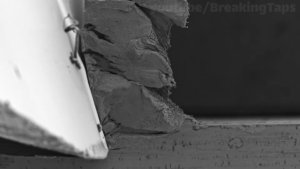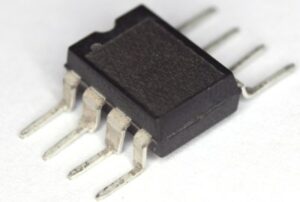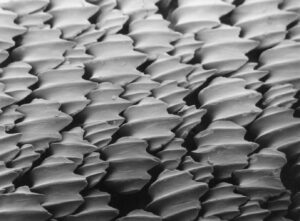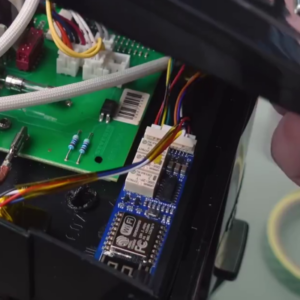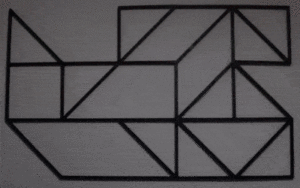We think of the power we generate as coming from all these different kinds of sources. Oil, gas, coal, nuclear, wind… so varied! And yet they all fundamentally come down to moving a gas through a turbine to actually spin up a generator and make some juice. Even some solar plants worked this way, using the sun’s energy to heat water into steam to spin some blades and keep the lights on.
A solar updraft tower works along these basic principles, too, but in a rather unique configuration. It’s not since the dawn of the Industrial Age that humanity went around building lots of big chimneys, and if this technology makes good sense, we could be due again. Let’s find out how it works and if it’s worth all the bluster, or if it’s just a bunch of hot air.
You Spin Me Right Up, Baby, Right Up
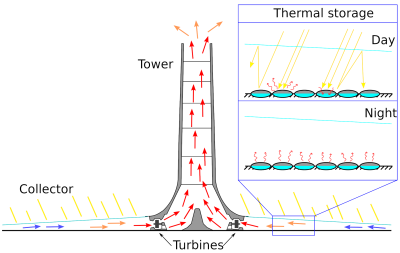
The concept of a solar updraft tower is relatively simple to understand. The idea is to create a large greenhouse-type structure surrounding a tall vertical chimney. As solar energy passes through the glass of the greenhouse, it heats the air inside as well as the floor and other contents. Since the greenhouse is, by and large, not completely open to the atmosphere, the heat cannot readily pass away by convection, and so the air within tends to become hotter than ambient temperature. That is, except for the chimney. As the air under the greenhouse grows warmer, it becomes less dense, and thus due to buoyancy forces, it wishes to travel upwards, and the only way out is via the chimney. It’s thus possible to install turbines in the base of the chimney to capture energy from this air as it travels up and out of the tower.
Beyond simple power generation, the solar updraft tower also offers some potential for energy storage, much like a hydroelectric dam. The sun can be used to heat the air under the greenhouse, but that air does not have to be immediately allowed to pass through the chimney. It can be stored for some time before passing it through the turbines and up the stack. Some concepts propose to further improve the storage capability by adding large water tanks as thermal sinks beneath the greenhouse. However, like all thermal storage, it’s time-limited, as the air in the greenhouse starts losing energy when the sun goes down and the ambient temperature drops.
Simple engineering tells us that the potential power output primarily relies on how much warm air you have to turn the turbine, and how much you can get it moving. Thus, a larger greenhouse collector area will have more power potential. So too will a taller chimney, which will create a greater pressure difference between the hot air at ground level and the cooler ambient air at the top. As you might imagine, there’s not a huge amount of energy packed in to air that’s just been warmed up a bit by the sun. Thus, to get significant output, you’d want a huge collector and a huge chimney. If you’re wondering about scale, you’d want to consider chimneys many hundreds of meters high, and greenhouses measured in square kilometers.
As a guide, one proposed project in Western Australia promised to generate 200 MW of power. The tradeoff? It involved a 1-km high tower and a collector 10 km in diameter, to be built at a cost of $1.67 billion. The engineering team behind the idea, Schlaich Bergermann and Partner, noted that solar updraft towers really only make sense at these massive scales. Smaller installations aren’t cost competitive with photovoltaic solar panels, but larger ones can be. Large facilities make enough power to offset the huge construction costs, and ongoing maintenance is cheap, as it really just involves keeping the turbines and generator up and running. There are no dirty panels to clean, for example.
The project for a solar updraft tower built in Spain committed to the bit: you need to build the chimney high to get the best out of it. The higher, the better! Credit: Widakora, CC BY-SA 3.0
" data-medium-file="https://platoaistream.com/wp-content/uploads/2024/01/solar-chimneys-viable-energy-solution-or-a-lot-of-hot-air.jpg" data-large-file="https://platoaistream.com/wp-content/uploads/2024/01/solar-chimneys-viable-energy-solution-or-a-lot-of-hot-air-2.jpg?w=660" class="wp-image-655675 size-medium" src="https://platoaistream.com/wp-content/uploads/2024/01/solar-chimneys-viable-energy-solution-or-a-lot-of-hot-air.jpg" alt width="400" height="253" srcset="https://platoaistream.com/wp-content/uploads/2024/01/solar-chimneys-viable-energy-solution-or-a-lot-of-hot-air-2.jpg 660w, https://platoaistream.com/wp-content/uploads/2024/01/solar-chimneys-viable-energy-solution-or-a-lot-of-hot-air-2.jpg?resize=250,158 250w, https://platoaistream.com/wp-content/uploads/2024/01/solar-chimneys-viable-energy-solution-or-a-lot-of-hot-air-2.jpg?resize=400,253 400w" sizes="(max-width: 400px) 100vw, 400px">By and large, solar updraft towers have remained largely conceptual, with few real-world projects built. The best example of an actual solar updraft tower was a small-scale effort built in Manzanares, a locale south of Madrid, Spain in 1982. It was built for an output of 50 kW, and intended to operate for just 3 years. It ran for 7 years in the end, before collapsing in 1989 due to storm winds and corroded guy wires holding up the 194-meter tower. The chimney was paired with a 244-meter diameter collector, using a combination of glass and plastic membranes to create the greenhouse.
The Manzanares tower was a grandiose thing, pictured here from under the polyester roof of its collector.
" data-medium-file="https://platoaistream.com/wp-content/uploads/2024/01/solar-chimneys-viable-energy-solution-or-a-lot-of-hot-air-1.jpg" data-large-file="https://platoaistream.com/wp-content/uploads/2024/01/solar-chimneys-viable-energy-solution-or-a-lot-of-hot-air-4.jpg?w=418" class="wp-image-655674 size-medium" src="https://platoaistream.com/wp-content/uploads/2024/01/solar-chimneys-viable-energy-solution-or-a-lot-of-hot-air-1.jpg" alt width="268" height="400" srcset="https://platoaistream.com/wp-content/uploads/2024/01/solar-chimneys-viable-energy-solution-or-a-lot-of-hot-air-4.jpg 1627w, https://platoaistream.com/wp-content/uploads/2024/01/solar-chimneys-viable-energy-solution-or-a-lot-of-hot-air-4.jpg?resize=167,250 167w, https://platoaistream.com/wp-content/uploads/2024/01/solar-chimneys-viable-energy-solution-or-a-lot-of-hot-air-4.jpg?resize=268,400 268w, https://platoaistream.com/wp-content/uploads/2024/01/solar-chimneys-viable-energy-solution-or-a-lot-of-hot-air-4.jpg?resize=418,625 418w, https://platoaistream.com/wp-content/uploads/2024/01/solar-chimneys-viable-energy-solution-or-a-lot-of-hot-air-4.jpg?resize=1028,1536 1028w, https://platoaistream.com/wp-content/uploads/2024/01/solar-chimneys-viable-energy-solution-or-a-lot-of-hot-air-4.jpg?resize=1371,2048 1371w" sizes="(max-width: 268px) 100vw, 268px">More recently, other pilot projects have experimented with the technology. Researcheres in Botswana experimented with a small-scale build of just 22 meters height with a small 15-meter diameter collector. The country has instead looked to photovoltaic and concentrated solar power concepts since.
Chinese efforts got a little further, but not by much. In Jinshawan, a $200 million project saw the construction of a solar tower on desert lands back in 2010. It combined solar updraft generation with a special air entry door that let it capture power from prevailing winds as well. Big plans were to see the build expand in multiple phases to eventually generate 27.5 megawatts, but it never came close. It achieved just 200 kilowatts, and was plagued by glass panels shattering in the greenhouse collector. It was originally supposed to have a 200-meter high chimney, but a nearby airport meant that it could only be built to 50 meters instead. This greatly limited the pressure differential available to help generate power from the heated air. The project continued for several years, but has made little impression.
The Chinese solar updraft tower can be seen on Google Maps via satelite view.
" data-medium-file="https://platoaistream.com/wp-content/uploads/2024/01/solar-chimneys-viable-energy-solution-or-a-lot-of-hot-air-1.png" data-large-file="https://platoaistream.com/wp-content/uploads/2024/01/solar-chimneys-viable-energy-solution-or-a-lot-of-hot-air-6.png?w=800" class="wp-image-655676 size-medium" src="https://platoaistream.com/wp-content/uploads/2024/01/solar-chimneys-viable-energy-solution-or-a-lot-of-hot-air-1.png" alt width="400" height="288" srcset="https://platoaistream.com/wp-content/uploads/2024/01/solar-chimneys-viable-energy-solution-or-a-lot-of-hot-air-6.png 1445w, https://platoaistream.com/wp-content/uploads/2024/01/solar-chimneys-viable-energy-solution-or-a-lot-of-hot-air-6.png?resize=250,180 250w, https://platoaistream.com/wp-content/uploads/2024/01/solar-chimneys-viable-energy-solution-or-a-lot-of-hot-air-6.png?resize=400,288 400w, https://platoaistream.com/wp-content/uploads/2024/01/solar-chimneys-viable-energy-solution-or-a-lot-of-hot-air-6.png?resize=800,576 800w" sizes="(max-width: 400px) 100vw, 400px">Solar updraft towers are an interesting concept, to be sure. They rely on simple physics and are easy to understand. However, to generate meaningful power, they require huge tracts of land and incredibly tall towers. They pose a great number of challenges, many of which are simply construction and land use related, and come with a great many unknowns.
In comparison, we’ve now learned how to stick solar panels on every flat surface going spare, and are able to generate huge amounts of power via that route. Heck, they’re even sticking them on water now. Few governments or businesses would want to accept a pie-in-the-sky power generation project involving construction on a massive scale when there are easier routes to go. It seems that technology has marched well past the point where solar updraft chimneys might be viable, but who knows! Maybe one day, someone with a great deal of money and a taste for megaprojects might just make one a reality once more.
- SEO Powered Content & PR Distribution. Get Amplified Today.
- PlatoData.Network Vertical Generative Ai. Empower Yourself. Access Here.
- PlatoAiStream. Web3 Intelligence. Knowledge Amplified. Access Here.
- PlatoESG. Carbon, CleanTech, Energy, Environment, Solar, Waste Management. Access Here.
- PlatoHealth. Biotech and Clinical Trials Intelligence. Access Here.
- Source: https://hackaday.com/2024/01/15/solar-chimneys-viable-energy-solution-or-a-lot-of-hot-air/
- :has
- :is
- :not
- :where
- $UP
- 1
- 10
- 1040
- 180
- 200
- 22
- 250
- 27
- 400
- 50
- 67
- 7
- a
- Able
- About
- Accept
- achieved
- actual
- actually
- adding
- again
- age
- AIR
- airport
- All
- allowed
- along
- also
- Ambient
- amount
- amounts
- an
- and
- Archive
- ARE
- AREA
- around
- AS
- At
- Atmosphere
- available
- away
- Baby
- base
- basic
- BE
- become
- becomes
- been
- before
- behind
- BEST
- between
- Big
- Billion
- Bit
- build
- Building
- built
- Bunch
- businesses
- but
- by
- came
- CAN
- Can Get
- cannot
- capability
- capture
- challenges
- cheap
- chinese
- clean
- Close
- Coal
- collector
- combination
- combined
- come
- coming
- committed
- comparison
- competitive
- completely
- Concentrated
- concept
- concepts
- conceptual
- Configuration
- Consider
- construction
- contents
- continued
- Cost
- Costs
- could
- country
- create
- credit
- day
- deal
- dense
- DESERT
- difference
- different
- does
- Door
- down
- Drops
- due
- easier
- easy
- effort
- efforts
- end
- energy
- Engineering
- enough
- entry
- Ether (ETH)
- Even
- eventually
- Every
- example
- Except
- Expand
- facilities
- few
- Find
- flat
- Floor
- For
- Forces
- from
- fundamentally
- further
- GAS
- generate
- generation
- generator
- get
- glass
- Go
- Goes
- going
- good
- google maps
- got
- Governments
- great
- greater
- greatly
- Ground
- Grows
- guide
- Guy
- Have
- height
- help
- here
- High
- higher
- holding
- HOT
- How
- How To
- However
- HTTPS
- huge
- Humanity
- Hundreds
- idea
- if
- imagine
- immediately
- improve
- in
- incredibly
- industrial
- inside
- install
- instead
- intended
- interesting
- into
- involved
- involves
- involving
- IT
- ITS
- jpg
- just
- Keep
- keeping
- Land
- lands
- large
- largely
- larger
- learned
- less
- let
- Level
- like
- Limited
- little
- locale
- looked
- losing
- Lot
- lots
- made
- maintenance
- make
- MAKES
- many
- Maps
- massive
- max-width
- maybe
- me
- meaningful
- meant
- measured
- might
- million
- money
- more
- moving
- much
- multiple
- Need
- never
- no
- noted
- now
- nuclear
- number
- of
- Offers
- offset
- Oil
- on
- once
- ONE
- ones
- ongoing
- only
- open
- operate
- or
- originally
- Other
- out
- output
- packed
- paired
- panels
- partner
- pass
- passes
- Passing
- past
- phases
- PHP
- Physics
- pilot
- Pilot projects
- plagued
- plans
- plants
- plastic
- plato
- Plato Data Intelligence
- PlatoData
- Point
- possible
- potential
- power
- pressure
- primarily
- principles
- project
- projects
- promised
- propose
- proposed
- rather
- readily
- real world
- Reality
- really
- recently
- related
- relatively
- rely
- remained
- require
- right
- roof
- routes
- running
- satellite
- saw
- Scale
- scales
- see
- seems
- seen
- sense
- several
- significant
- Simple
- simply
- since
- small
- smaller
- So
- solar
- solar energy
- solar panels
- Solar Power
- solution
- some
- Someone
- Sources
- South
- Spain
- special
- Spin
- square
- stack
- starts
- Steam
- Stick
- storage
- stored
- Storm
- structure
- Sun
- supposed
- sure
- Surface
- Surrounding
- SVG
- Tanks
- taste
- team
- Technology
- tells
- tends
- than
- that
- The
- Them
- There.
- thermal
- These
- they
- thing
- think
- this
- Through
- Thus
- time
- to
- too
- top
- Tower
- travel
- travels
- turbine
- TURN
- under
- understand
- unique
- upwards
- us
- use
- used
- using
- vertical
- via
- viable
- View
- want
- warm
- Warmer
- was
- Water
- Way..
- we
- WELL
- went
- were
- Western
- when
- which
- WHO
- Wikipedia
- will
- winds
- wishes
- with
- within
- wondering
- worked
- works
- worth
- would
- years
- yet
- you
- zephyrnet


